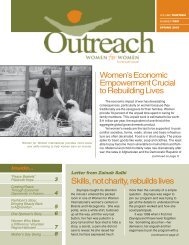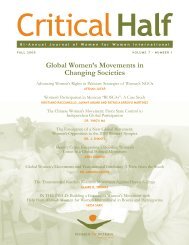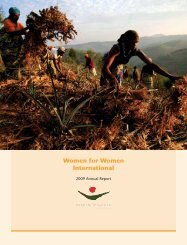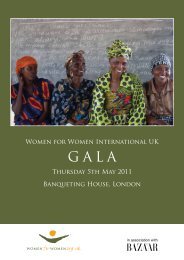Gender and Constitution Building - Women for Women International
Gender and Constitution Building - Women for Women International
Gender and Constitution Building - Women for Women International
You also want an ePaper? Increase the reach of your titles
YUMPU automatically turns print PDFs into web optimized ePapers that Google loves.
grams frequently resulted in gender discrimination. For<br />
example, female combatants initially did not receive<br />
equal treatment in the allocation of crucial resources<br />
such as l<strong>and</strong>. The reasons were many, ranging from<br />
machismo at the grassroots level to lack of support from<br />
the male-dominated leadership of the guerrilla movement.<br />
Nidia Díaz, the FMLN official originally in charge<br />
of the l<strong>and</strong> program, affirmed that although the discrimination<br />
of female combatants was not officially<br />
sanctioned or designed, the socio-cultural context often<br />
made it a reality. 13 Lorena Peña concurred: “I believe<br />
that the principal problem that we have experienced<br />
is that the reintegration of the female combatant<br />
into civilian life has taken place under the classical<br />
sexist concepts that have predominated in all political<br />
<strong>for</strong>ces of the country, including the FMLN.” 14 Peña<br />
claimed that an estimated 70 to 80 percent of female<br />
combatants initially did not receive the benefits allocated<br />
to them.<br />
Significantly, in-depth studies of the reintegration<br />
programs demonstrated that these early instances of<br />
discrimination were subsequently rectified. 15 The reason<br />
<strong>for</strong> this reversal could be found in the mobilization<br />
of the women’s movement. Together with female<br />
FMLN activists, it succeeded in exerting sufficient pressure<br />
on the government <strong>and</strong> the FMLN to reverse discriminatory<br />
practices.<br />
Guatemala<br />
In Guatemala, the challenge of reintegrating the<br />
URNG combatants into civilian life was enormous. Of<br />
particular concern were the poverty <strong>and</strong> ethnic backgrounds<br />
of the ex-combatants. The majority of the<br />
URNG’s personnel came from Guatemala’s 21 groups<br />
of indigenous peoples <strong>and</strong> belonged to the most<br />
marginalized sectors of society. Not surprisingly, evaluations<br />
of the peace accords’ impact sounded a pessimistic<br />
note. Leaders of the women’s movement argued<br />
that the dem<strong>and</strong>s of women in respect to the implementation<br />
of the accords lacked tangible results <strong>and</strong><br />
that commitments had not been converted into actions.<br />
The government was criticized <strong>for</strong> “failing to have an<br />
idea of how to attend to women’s historic problems”<br />
<strong>and</strong> <strong>for</strong> lacking a strategy of action designed to ensure<br />
that the provisions of the accords would not remain<br />
empty words. 16 With a government unwilling to follow<br />
through on commitments made in the accords, <strong>and</strong> a<br />
demobilized guerrilla movement lacking the political<br />
clout necessary to hold the government accountable,<br />
women were left out in the cold.<br />
Analysis<br />
The current emphasis on the inclusion of gender<br />
equality provisions in peace accords <strong>and</strong> subsequent<br />
constitutions is only a necessary first step. While it is<br />
important to fight <strong>for</strong> <strong>for</strong>mal gender equality, it is the<br />
implementation of these <strong>for</strong>mal agreements that really<br />
matters. Peace accords <strong>and</strong> constitutions that institutionalize<br />
gender equality can easily remain utopian visions<br />
unless a concerted ef<strong>for</strong>t by societal <strong>for</strong>ces trans<strong>for</strong>ms<br />
these visions into reality.<br />
El Salvador<br />
In El Salvador, the women’s movement evolved into<br />
an effective advocate <strong>for</strong> gender equality <strong>and</strong> thus was<br />
able to correct the imbalance created by peace accords<br />
that failed to address women’s issues. The movement’s<br />
ef<strong>for</strong>ts were greatly helped by the strong political party<br />
that emerged out of the <strong>for</strong>mer guerrilla movement. The<br />
FMLN’s political strength permitted the new party to<br />
pressure the government to adhere to the provisions of<br />
the peace accords, which established benefits <strong>for</strong> the excombatants.<br />
Female FMLN militants were successful in<br />
gaining substantial representation in the FMLN’s leadership<br />
structures <strong>and</strong> in the party’s parliamentary representation.<br />
While <strong>for</strong>mal gender equality was achieved in<br />
most instances during the implementation of the benefits<br />
programs, the prevailing cultural norms impeded<br />
progress toward substantive equality. Nevertheless, the<br />
Salvadoran experience teaches us that it is essential that<br />
ex-combatants <strong>for</strong>m strong political parties to ensure<br />
the implementation of any accord.<br />
Guatemala<br />
The Guatemalan peace accords can best be compared<br />
to the constitutions of many countries that guarantee<br />
extensive rights to the citizens that in the end are<br />
rarely en<strong>for</strong>ced. The accords establish normative goals<br />
<strong>for</strong> the future of Guatemalan citizens but not an en<strong>for</strong>ceable<br />
code of law. Some commentators have noted<br />
that “the Guatemalan agreement contains more wide<br />
ranging language on social <strong>and</strong> economic areas, by far,<br />
than the Salvadoran accord, but a great many of the<br />
provisions are stated in sufficiently general terms as to<br />
make them virtually unen<strong>for</strong>ceable,” a fact described as<br />
the Achilles’ heel of the accords. 17 There is strong consensus<br />
that the URNG’s weakness at the bargaining table<br />
made it impossible <strong>for</strong> the guerrilla leadership to negotiate<br />
more specific, en<strong>for</strong>ceable agreements–a reality that<br />
impedes the full realization of the provisions in the accords.<br />
The URNG continued to exhibit political weakness<br />
during the implementation phase, at a time when a<br />
CRITICAL HALF 17







